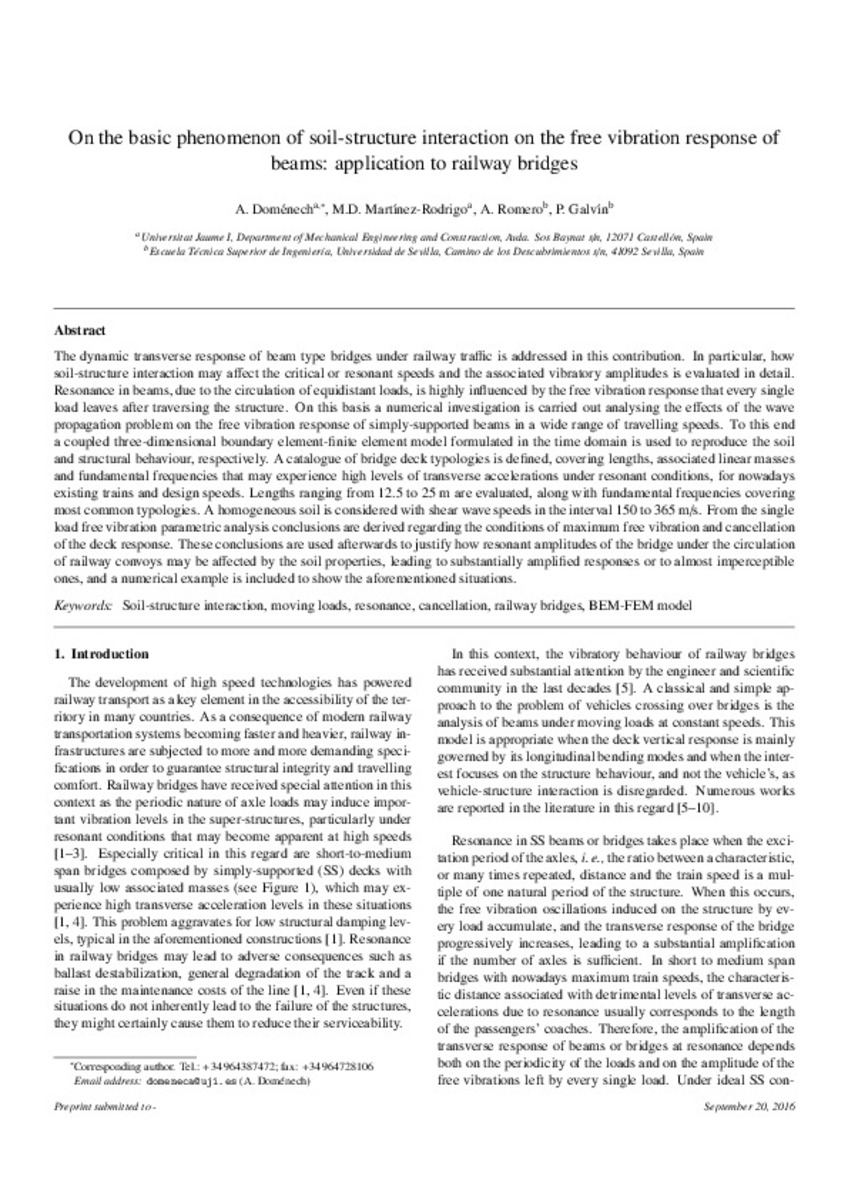Mostrar el registro sencillo del ítem
Soil–structure interaction effects on the resonant response of railway bridges under high-speed traffic
| dc.contributor.author | Doménech Monforte, Alejandro | |
| dc.contributor.author | Martínez-Rodrigo, María D. | |
| dc.contributor.author | Romero Ordóñez, Antonio | |
| dc.contributor.author | Galvín, Pedro | |
| dc.date.accessioned | 2016-10-06T14:30:35Z | |
| dc.date.available | 2016-10-06T14:30:35Z | |
| dc.date.issued | 2015-08 | |
| dc.identifier.citation | DOMÉNECH, Alejandro, et al. Soil–structure interaction effects on the resonant response of railway bridges under high-speed traffic. International Journal of Rail Transportation, 2015, vol. 3, no 4, p. 201-214. | ca_CA |
| dc.identifier.uri | http://hdl.handle.net/10234/163499 | |
| dc.description.abstract | In the present contribution, the dynamic behaviour of beams traversed by moving loads including soil–structure interaction (SSI) is investigated. The main application of the study is to analyse the effects of SSI on the resonant response of bridges caused by railway traffic. As this phenomenon is highly influenced by the free vibration response of the deck, a numerical investigation is carried out by analysing the effects of the wave propagation problem on the transverse-free vibration response of beams under moving loads in a wide range of velocities. To this end, a coupled three-dimensional boundary element-finite element model formulated in the time domain is used to reproduce the soil and structural behaviour, respectively. A subset of bridges is defined considering span lengths ranging from 12.5 to 25 m and fundamental frequencies covering associated typologies. A homogeneous soil is considered with shear wave velocities ranging from 150 to 365 m/s. From the single load-free vibration parametric analysis, conclusions are derived regarding the conditions of maximum free vibration and cancellation of the response. These conclusions are used afterwards to justify how resonant amplitudes of the bridge under the circulation of railway convoys are affected by the soil properties, leading to substantially amplified responses or to almost cancelled ones, and numerical examples are included to show the aforementioned situations. | ca_CA |
| dc.description.sponsorShip | The first two authors would like to acknowledge the financial support provided by Universitat Jaume I under the research project P1 1B2015-54. The third and fourth authors would like to acknowledge the financial support provided by the Spanish Ministry of Economy and Competitiveness (Ministerio de Econom´ıa y Competitividad) under the research project [BIA2013-43085-P]. The authors also wish to acknowledge the support provided by the Andalusian Scientific Computing Centre (CICA). | ca_CA |
| dc.format.extent | 14 p. | ca_CA |
| dc.format.mimetype | application/pdf | ca_CA |
| dc.language.iso | eng | ca_CA |
| dc.publisher | Taylor & Francis | ca_CA |
| dc.relation.isPartOf | International Journal of Rail Transportation, 2015, vol. 3, no 4 | ca_CA |
| dc.rights.uri | http://rightsstatements.org/vocab/CNE/1.0/ | * |
| dc.subject | railway bridges | ca_CA |
| dc.subject | soil–structure interaction | ca_CA |
| dc.subject | resonance | ca_CA |
| dc.subject | cancellation | ca_CA |
| dc.subject | moving loads | ca_CA |
| dc.subject | BEM-FEM coupled models | ca_CA |
| dc.title | Soil–structure interaction effects on the resonant response of railway bridges under high-speed traffic | ca_CA |
| dc.type | info:eu-repo/semantics/article | ca_CA |
| dc.identifier.doi | http://dx.doi.org/10.1080/23248378.2015.1076621 | |
| dc.rights.accessRights | info:eu-repo/semantics/openAccess | ca_CA |
| dc.relation.publisherVersion | http://www.tandfonline.com/doi/abs/10.1080/23248378.2015.1076621 | ca_CA |
| dc.edition | preprint | ca_CA |
Ficheros en el ítem
Este ítem aparece en la(s) siguiente(s) colección(ones)
-
EMC_Articles [807]







